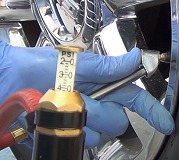I have the most experience with different tire brands between Goodyear and Michelin because most new Chrysler products came with one of those. Neither one was better or worse, but they were definitely different.
Between General Motors, Volkswagen, and BMW, it's a toss-up as to which dealership I would least want to visit, but this might be a time to speak with the alignment specialist at the dealership and ask them what they're doing about any common tire wear issues. I can share my experience with Dodge trucks to put things in perspective. They called for 1/8" plus or minus 1/8" total toe-in which was fairly standard on all Dodge and GM trucks for decades. You could set that with a tape measure and be close enough to prevent tire wear. (That's like trying to reach up and dunk a baseball through a basketball hoop)! At that setting on the redesigned '94 and newer models that would chew up Goodyear tires but not Michelins. The setting that worked best for Goodyears and eliminated almost all of that wear was 1/16" toe-in exactly. That difference from 1/8" to 1/16" was so extremely insignificant on any other car or truck but it is what it took to get good tire wear. (No tape measure there; you needed a very precise alignment computer to get that accurate. (That's like threading a needle with a magnifying glass). No experienced alignment mechanic would ever believe that 1/16" difference would affect tire wear that much unless they saw it for themselves. That's what I suspect has happened with your Cooper tires. It's not that they're better or worse; it's that they're different, just like my Dodge story that only pertained to Goodyear tires.
Normally I told customers who were planning on buying new tires, THEN having their vehicle aligned, that I would prefer to align it with their old tires so I could read the wear patterns and know what to adjust, but I had to explain how important it was that I know what brand of tires they were planning on buying. Different brands have different rubber compounds that squirm differently and stick to the road surface differently. Different tread designs react differently too setting up different wear patterns. The only accurate way to compare the wear of two sets of tires is if they're the same brand and model but even then there could have been changes made in the design that we don't know about.
I have a friend who used to own a tire shop and sold Cooper tires. From everything I've heard from his customers, those are very good tires. What you have to understand is tread wear patterns aren't caused by a defect in a tire. Those patterns come from the tire bouncing excessively, (shock absorbers), oscillating left and right rapidly, (worn lower control arm bushings which seem to be fairly common today), the tire is skidding sideways a very tiny amount as it goes down the road, (misaligned toe), or it's worn more on the inner or outer edge, (misadjusted camber causing the tire to tilt in or out on top). Misadjusted camber only affects that one tire although it can be misadjusted on both tires. Toe wear always affects both tires on the same axle regardless if one or both are misadjusted.
You also have to consider the mileage on the vehicle and the wear on the suspension parts. Had you started out with Cooper tires, you might have gotten 46,000 miles out of them, then 33,000 from the replacement Goodyears.
The lower control arm bushings I mentioned should be inspected. GM also used to have a lot of trouble with worn idler arms that allowed the right front tire to bounce left and right a lot, but your truck uses rack and pinion steering which eliminates many of those parts. I don't know the history of the ball joints on your model but I do know the Blazers wore them out very fast, as in every year or two. A worn ball joint can lead to a lot of tire wear.
My first recommendation is to get another opinion from an independent tire and alignment shop. They often won't give you a warranty on their new tires unless they can identify the cause of the wear and correct it, and without that warranty, you won't buy the tires. They want to sell you new tires so they're going to know what to look for to solve the wear.
My second, less valuable recommendation is to visit a community college where they have automotive textbooks in the library and look at pictures of tire wear. You'll see that all the causes that are listed are related to worn parts and / or alignment problems, not defects in the tire's manufacture.
Hopefully someone will have a suggestion on how to solve that wear, but then one more thing you should be aware of is most people will suggest rotating the tires front-to-back thinking the wear will smooth out from being on a solid rear axle. In fact that only happens about half of the time. The other half the wear stays the same or even gets worse. It has to do with how the blocks of tread contact the road and squirm. I put some really chewed up tires on the back of an old rear-wheel-drive Chrysler station wagon that made it real easy to paddle through deep snow but eventually they did wear smooth. I've had other severely worn used tires that I put on the front of a few cars that never smoothed out even though the alignment was fine.
Tuesday, June 19th, 2012 AT 8:28 PM



